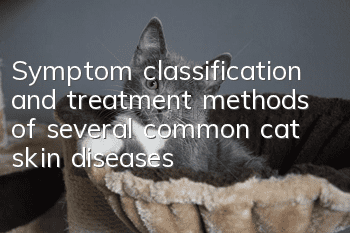Symptom classification and treatment methods of several common cat skin diseases

Classification and prevention and treatment of common cat skin diseases
1. Acne (often called black chin)
Cat acne, also known as cat acne, is familiar to everyone. It often manifests as the accumulation of black secretions on the cat’s chin, whisker roots, and around the lips.
The reason for a black chin may be related to the cat eating too much greasy food. In addition, improper cleaning of the food bowl leads to the growth of bacteria. The cat has difficulty cleaning the hair on its chin, which leads to the accumulation of black secretions.
When acne on the chin develops seriously, it will turn into folliculitis and furuncle, which will be more troublesome to treat. Therefore, a cat’s black chin deserves the attention of its owners.
Acne treatment and prevention
Treatment: You can perform partial shaving, clean the cat’s chin with warm salt water, and then use antibiotic ointment 1-2 times a day.
Prevention: Avoid feeding greasy food to cats; keep food bowls clean and try to use stainless steel and ceramic food bowls (plastic bowls can easily breed bacteria); frequently wipe the cat’s chin with light salt water or soapy water.
2. Mold (often called cat ringworm)
Mold is what we often call cat ringworm. It is extremely contagious and can be spread between humans and cats. It is a disease common to humans and zoonoses.
Cats suffering from tinea felis often show local hair loss, and there is a lot of dandruff accumulation in the hairless area. Generally, there are no obvious symptoms of itching. Therefore, many careless owners only discover when their cats are shedding a lot of hair.
When a cat’s immunity is reduced or the environment is humid, cats are easily infected with mold. In the final analysis, this is directly related to the owner's poor care.
Treatment and prevention of mold:
Treatment: Medicinal bath and application of antifungal drugs.
Prevention: Owners should pay attention to the hygiene of the home environment, keep it ventilated and dry, and disinfect frequently. For infected cats, used towels should be discarded or disinfected to prevent transmission to humans and other animals.
3. Scabies
Scabies in cats is caused by scabies infection by ear mites.
Perhaps the poop collectors do not associate cat ear mites with skin scabies. In fact, ear scabies is really nasty and highly contagious.
Scabies initially starts on the edges of the ears and then affects the cat's entire face, head, and feet. Unlike cat ringworm, scabies causes extreme itching in cats, and the infected skin may thicken and lose hair.
If a cat is infected with scabies, it must be treated promptly and an Elizabethan ring should be worn on it to prevent the cat from scratching its skin. Households with many cats should pay special attention toNote that cats with scabies should be isolated.
Treatment and prevention of scabies:
Treatment: Use scabies medicinal lotion for 1-2 months;
Prevention: Regularly deworm cats externally, check or clean their ear canals regularly, and avoid contact with infected cats. What ear scabies fears most is a clean environment. As long as scavengers pay attention to cat ear hygiene, ear scabies will not have an opportunity to take advantage of it.
4. Stallion Tail
Stallion tail means that the sebaceous glands at the base of a cat's tail secrete too much oil, resulting in a large amount of oil accumulation in the tail. It is more common in unneutered male cats.
Most cats will not feel discomfort, but if there is a secondary infection, it may cause varying degrees of itching, and the cat may lick, scratch and bite its tail excessively.
Treatment and prevention of stallion tail:
Treatment: Shaving; cleaning the affected area with chemicals, 2-3 times a week; wiping with light salt water or tea water. If the cat develops a secondary infection, it needs to be smeared with antibiotics or sent to a doctor in time for appropriate treatment according to the situation. (Treats *** similar to acne)
Prevention: Avoid feeding cats too greasy food; some male cats will improve after neutering.
5. Atopic dermatitis
Atopic dermatitis in cats is generally an allergy caused by long-term exposure to a certain foreign body. Only a very small number of cats have congenital allergies.
Cat allergens include fleas, food and inhaled dust allergies. The most common is flea allergy, followed by food allergy.
Cat allergy symptoms often include skin inflammation such as itching, hair loss, and erythema, and otitis externa may also occur. Any part of a cat's body can be susceptible to allergies.
Treatment and prevention of allergic dermatitis
Treatment: Antibiotic treatment to prevent secondary bacterial infection; apply antipruritic agent; provide hypoallergenic feed, or single-formula feed to reduce exposure to allergens.
Prevention: remove allergens, do external deworming for cats; eliminate mosquitoes in the home; provide cats with hypoallergenic food and pay attention to nutritional supplements.
Regarding the phenomenon of excessive licking caused by cats’ psychological stress, it is generally a common manifestation of cats’ stress reaction due to external stimulation. Another situation is that the owner neglects the cat for a long time, which leads to increased loneliness and anxiety in the cat.
Therefore, when a cat licks its fur excessively due to mental illness, the owner should play with the cat more, distract the cat's attention, pet the cat more, and communicate with the cat more.
The above are relatively common cat skin diseases. To avoid suspicion of advertising, we will not make detailed recommendations. You can refer to the skin diseases according to the skin conditions.Find the corresponding medicine by the name of the disease. For fungal infected skin diseases, you can choose human ointments, but you should prevent cats from licking them. There is a mixed bag of veterinary drugs on the market. Many drugs are advertised like dragons and have the effects of insects. You must choose carefully.
- When is the best age to neuter a cat?
- Symptoms and Treatment of Feline Coccidiosis
- Is it better for cats to eat cat food? The correct way to feed cats!
- Analysis of the causes of cats’ loss of appetite, a must-read for cat owners!
- How do cats vomit hairballs? How does a cat spit out hairballs to eat?
- The cat has a hoarse voice but is in good spirits
- How to get your cat to take a bath quietly
- Why don’t cats eat boiled chicken breasts?
- How old does a cat get its teeth?
- How to prevent cat ringworm? Disinfection of the environment is important



